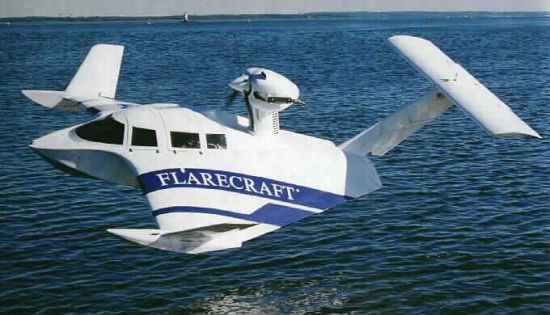To: demlosers
These look to have virtually the same silhouette.


42 posted on
04/04/2006 11:16:34 PM PDT by
LibertarianInExile
(Freedom isn't free--no, there's a hefty f'in fee--and if you don't throw in your buck-o-5, who will?)
To: LibertarianInExile
Good catch!
Iranian developed flying boat my #ss.
To: LibertarianInExile
Unless the Iranians have some major aeronautical talent they're not telling anyone, this may not be a very stable flying configuration, based on accident history. From Forbes, 10/1/2001:
A Wing and a Prayer
Monte Burke, 10.01.01
Would you be willing to commute in a flying ferryboat?
William Russell thought his dream of a hybrid boat-plane was finally taking off as he saw his Flarecraft rise above Long Island Sound one recent morning. Within seconds the five-seat winged craft was zipping 5 feet over the water at 60mph. It was a proud moment for Russell, who watched along with an executive from Lockheed Martin, which had agreed to buy two of the unlikely vessels.
Less than a minute into the demo, the Flarecraft pitched up into the air, crashing on its side in a shower of water and plane parts. The pilot wasn't hurt, but it was another setback for Russell, 53, who has spent 14 years and $10 million trying to revolutionize water travel.
With a 225hp Continental aircraft engine, 21-foot wingspan and an airplane-shaped body, the Flarecraft can travel 350 miles in three and a half hours on 47 gallons of fuel. Before taking off it floats like a seaplane on pontoons attached to its wingtips. At 20mph it begins to lift the pontoons, and at 60mph it's airborne, skirting the water by 1 to 10 feet. It works by using "wing-in-ground effect." The shape of the Flarecraft's wings slow down air under the wing, lifting the craft while decreasing drag--similar to the way a bird uses the air when it swoops near water.
A former investment banker, Russell dreamed of a newfangled commuter craft while schlepping to Wall Street on the subway in 1987. A sailboat racer and radio-controlled-plane junkie, he fantasized about a small, Jetsonesque vessel that could travel by air but take off and land in water like a seaplane. Then a friend mentioned the late Alexander Lippisch, a German who discovered wing-in-ground effect. Russell licensed the patents from Lippisch's widow for an undisclosed royalty.
He had German firm Messerschmitt Bolkow Blohm develop ultralight planes, but scrapped them when he discovered the bodies were too heavy. Russell then worked with boatmaker Merrifield-Roberts. In 1994 the four-seat Trainer, with a Lycoming 160hp engine, was featured as a $250,000 pleasure craft in the Neiman Marcus Christmas catalog. Despite 400 inquiries from well-to-do thrill seekers, Russell backed out of selling the Trainer, fearing liability. Merrifield bowed out, too. "We didn't feel it was a viable vessel," says John Merrifield, cofounder of the boatmaker. "It wasn't properly engineered."
Russell refocused on slightly larger craft that companies could use as ferries--assuming the risks themselves. He coaxed $5 million from investors and manufacturers, including Ticom, a former Northrop Grumman unit, to develop the current model, which adds a seat and boosts the payload to 1,200 pounds.
But as Lockheed learned, the latest version is still far from perfect. Surface tension in the water can sling the craft out of control or cause it to bounce violently. There's also a tendency for the craft to pitch nose up. Such problems have led to five wrecks. In April a customer wiped out spectacularly in Rhode Island's Narragansett Bay after altering the design of the plane. The pilot was injured and the plane destroyed. The same month the Coast Guard banned civilians from the craft and restricted the times and areas in which it can fly.
Russell is trying to drum up another $10 million to develop a 12-seater. The idea is to compete with island ferryboats in places like Greece and the Bahamas. By his math, some 300 Flarecrafts could generate $1 billion in sales charging $1 a mile per seat. It might be easier to put a pig into self-propelled orbit.57 posted on
04/05/2006 7:34:47 AM PDT by
Yossarian
("If you're going through hell, KEEP GOING!" -- Winston Churchill)
FreeRepublic.com is powered by software copyright 2000-2008 John Robinson



